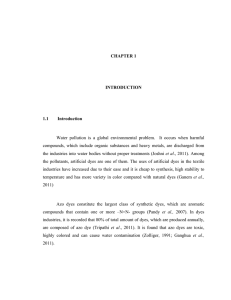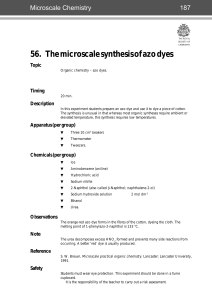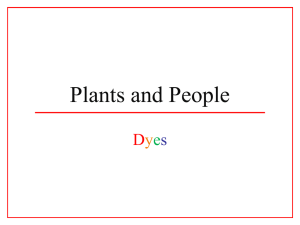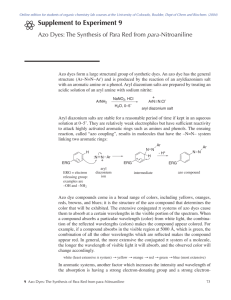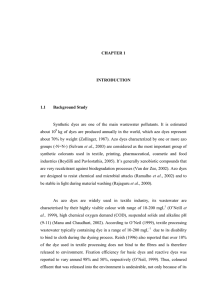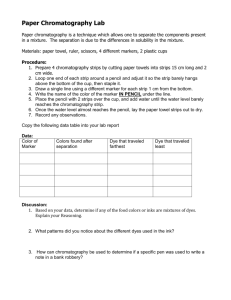Word
advertisement
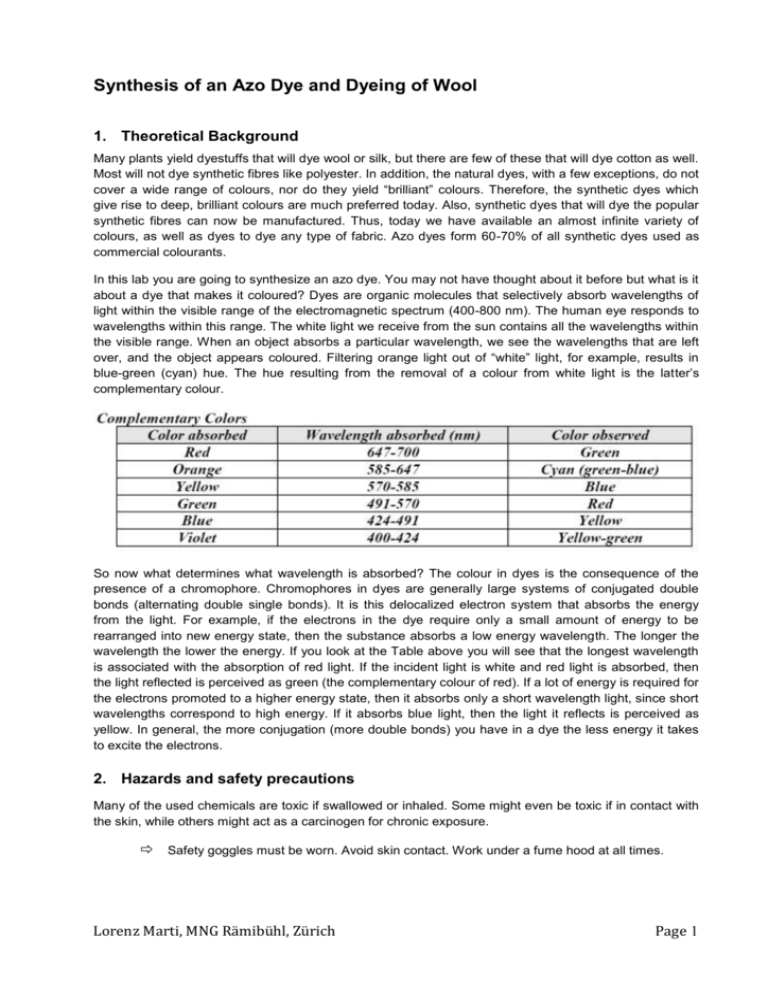
Synthesis of an Azo Dye and Dyeing of Wool 1. Theoretical Background Many plants yield dyestuffs that will dye wool or silk, but there are few of these that will dye cotton as well. Most will not dye synthetic fibres like polyester. In addition, the natural dyes, with a few exceptions, do not cover a wide range of colours, nor do they yield “brilliant” colours. Therefore, the synthetic dyes which give rise to deep, brilliant colours are much preferred today. Also, synthetic dyes that will dye the popular synthetic fibres can now be manufactured. Thus, today we have available an almost infinite variety of colours, as well as dyes to dye any type of fabric. Azo dyes form 60-70% of all synthetic dyes used as commercial colourants. In this lab you are going to synthesize an azo dye. You may not have thought about it before but what is it about a dye that makes it coloured? Dyes are organic molecules that selectively absorb wavelengths of light within the visible range of the electromagnetic spectrum (400-800 nm). The human eye responds to wavelengths within this range. The white light we receive from the sun contains all the wavelengths within the visible range. When an object absorbs a particular wavelength, we see the wavelengths that are left over, and the object appears coloured. Filtering orange light out of “white” light, for example, results in blue-green (cyan) hue. The hue resulting from the removal of a colour from white light is the latter’s complementary colour. So now what determines what wavelength is absorbed? The colour in dyes is the consequence of the presence of a chromophore. Chromophores in dyes are generally large systems of conjugated double bonds (alternating double single bonds). It is this delocalized electron system that absorbs the energy from the light. For example, if the electrons in the dye require only a small amount of energy to be rearranged into new energy state, then the substance absorbs a low energy wavelength. The longer the wavelength the lower the energy. If you look at the Table above you will see that the longest wavelength is associated with the absorption of red light. If the incident light is white and red light is absorbed, then the light reflected is perceived as green (the complementary colour of red). If a lot of energy is required for the electrons promoted to a higher energy state, then it absorbs only a short wavelength light, since short wavelengths correspond to high energy. If it absorbs blue light, then the light it reflects is perceived as yellow. In general, the more conjugation (more double bonds) you have in a dye the less energy it takes to excite the electrons. 2. Hazards and safety precautions Many of the used chemicals are toxic if swallowed or inhaled. Some might even be toxic if in contact with the skin, while others might act as a carcinogen for chronic exposure. Safety goggles must be worn. Avoid skin contact. Work under a fume hood at all times. Lorenz Marti, MNG Rämibühl, Zürich Page 1 3. Reaction scheme of an azo coupling + N N NH 2 + Cl– + NaCl + 4 H2O + NaNO2 + 2 H3O+ + 2 Cl– Diazonium salt Azo component + OH N N + H2O + Coupling reagent N=N + OH + H3O Azo dye 4. Equipment Hot plate, crystallising dish, measuring cylinder (10ml), glass stirring rod, thermometer, measuring pipette (10ml), funnel, dropping pipette 5. Procedure 1. In a 100ml beaker weigh 1 g of sulfanilic acid or anthranilic acid and 0.5 g Na2CO3. Add 10 ml of distilled water. Heat on the hotplate until everything has been dissolved. 2. Cool it down to 15°C using a mixture of ice and water in a crystallising dish. solution 1 3. In a 50ml beaker weigh 1g NaNO2, add 2.5ml of distilled water and pour to solution 1. 4. In a 100ml beaker weigh 7g of crushed ice and add 1ml concentrated hydrochloric acid. While stirring slowly add solution 1. Then let it rest for 5 minutes. The diazonium salt is now forming. solution 2 5. In a 250ml beaker weigh either: a.) 1g of resorcin b.) 1.5 ml of Schaeffer’s acid c.) 3g H-acid or d.) 3g of R-acid 6. Add 6ml of glacial acetic acid (100% acetic acid) and stir. The result is a suspension rather than a solution solution 3 7. While stirring add solution 2 to solution 3. Now the azo dye is forming. 6. Dying a test strip and some wool 8. In a 400ml beaker dissolve some of your dye with 200ml of water and 10ml of diluted sulphuric acid (2mol/L). How much of your dye to take depends on its intensity and colour. Use little at first. 9. Add 2 test strips and 2 short strings of wool and heat to boiling. 10. Remove test strips and wool and rinse thoroughly with water. Dry with paper tissue and hair dryer. 7. Disposal The aqueous parts can be disposed down the drain. Put the solid dyes into the waste bin. 8. Comparing the dyes, spectra If there is enough time left, the spectra of the dyes can be compared using a UV/VIS-spectrometer. Lorenz Marti, MNG Rämibühl, Zürich Page 2


